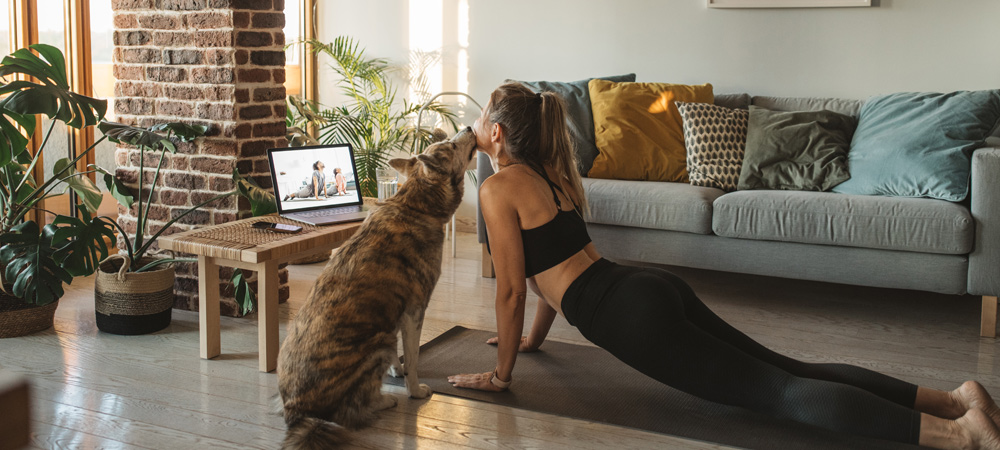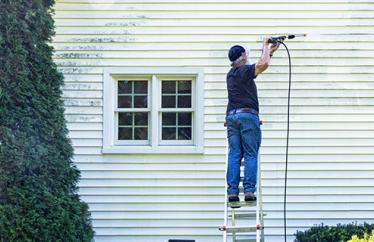Heading back to the office? Remote work was every dog’s dream: Owners staying home to work means more love and attention. As folks spend more time outside of the home or go back to work in person, pets can be deeply affected and need time to adjust.
Some furry friends may even experience separation anxiety when their owners leave the home. These feelings can present themselves in ways like your pup destroying your favorite couch cushions, which can be protected with home insurance. In this guide, we’ll cover leaving your dog home alone while at work (or anywhere else) and how to make sure your dog is safe and happy while you do so.
How to leave your dog home alone: 8 best practices
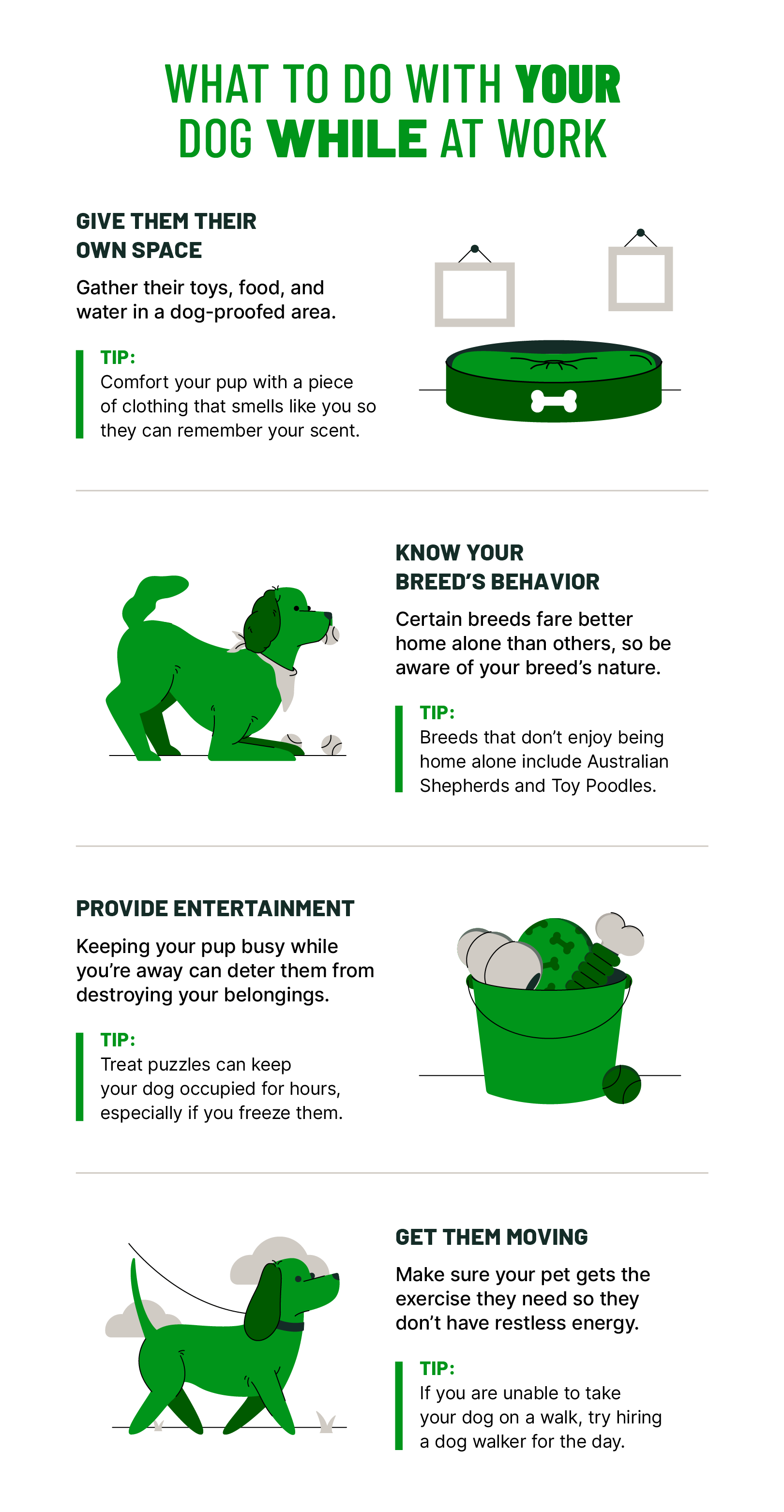
1. Give your pup a designated space
Wondering where to keep dogs while at work? Designate a space in your home where your dog can feel safe with their bed, a few toys, food, and water. If your pup has a tendency to chew on your favorite slippers, using a pet fence can keep them in their designated space. It’s also a good idea to dog-proof their area so they don’t destroy anything, get hurt, or eat something bad for them.
2. Know your breed's behavior
Certain dog breeds are better being left alone at home than others, like:
- French bulldogs
- Basset hounds
- Maltese
- Shar Peis
- Greyhounds
Make sure to research your dog breed’s characteristics so you’re taking the right steps to make them comfortable at home alone. Dog breeds that aren’t good at being left home alone include Toy Poodles, Australian Shepherds, and American Pit Bull Terriers. It’s not advised to leave young puppies home alone, especially for long periods. Start slow, and train your dog to gradually become more and more comfortable while you’re away.
3. Provide entertainment
Keeping your furry friend busy will make the time that you’re away fly by. There are plenty of toys and treats that you can give your pup. Try giving them a hollow toy with peanut butter inside. For a challenge, you can pop the peanut butter-filled toy in the freezer for a chilly treat. For more senior dogs, you can use an interactive puzzle that will keep them occupied for a while.
If your pup loves to sleuth around the house, you can set up a scavenger hunt by placing pieces of kibble in the places they frequent. You can also hide those food-stuffed puzzle toys to add difficulty to the challenge. Doing this can help your dog create a positive association with your leaving home.
4. Make sure they go to the bathroom
Depending on their age and breed, dogs typically need to go to the bathroom between three and five times a day. Puppies and senior dogs will probably need to go more often than that: Puppies can typically hold going to the bathroom for one hour per month of age (four-month-old puppy = four hours), whereas adult dogs that are one year or older can hold it for up to six hours.
There are plenty of bathroom solutions for leaving dogs at home like pee pads or grass pads, which can be their designated place to go to the bathroom if you’re unable to take them out while you’re away. Another option is adding a dog door to your home so they can go in the backyard or hiring a dog walker to take them out for you.
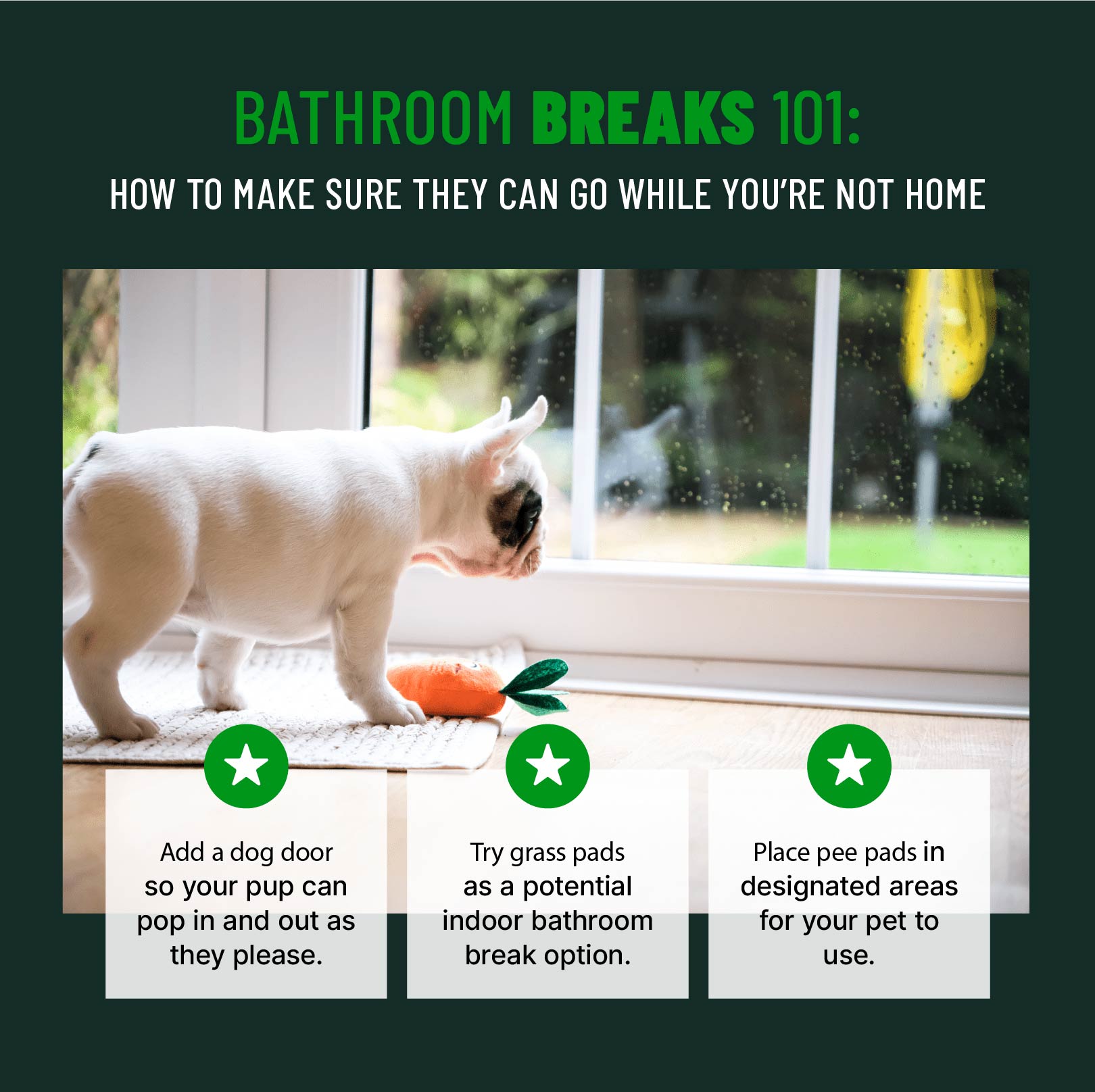
5. Get them moving
Like their humans, dogs need exercise: Taking them for a long walk or visiting a dog park before or after you’re away is a great way to expend their pent-up energy. Walks provide an outlet for them to get moving so they don’t feel cooped up at home. If you walk your dog before you leave, they’ll have burned through their energy that might otherwise be spent destroying belongings
6. Leave your curtains or blinds open
Opening your blinds or curtains can benefit dogs and make them feel less trapped at home. They like to see what’s happening out in the world — especially if that means seeing you walk up to the door.
Some dogs might get too excited or anxious by what they see outside (e.g., a squirrel or a neighborhood cat), so test out how your dog feels with the blinds open while you’re home. If they start barking or scratching at the window at the sight of something outside, it might be better to open a different window, like one facing your backyard.
7. Start slow and practice
For new pups that haven’t been left at home alone before, you’ll want to start slow. Practice leaving your home and coming back while gradually increasing the time away each time. Start with a few minutes, then move up to 15 minutes, half an hour, and so on.
You can even create associations for your dog by giving them a treat when you leave or jingling your keys when you’re about to head out the door. Make sure to stay calm and collected so that you don’t leave your pup emotionally upset.
8. Greet them with love when you return
When you return from being away from your pup, be sure to greet them with excitement and love. Taking your dog for a walk or a trip to the dog park can reward them for their good behavior.
12 tips for leaving your dog home alone while at work
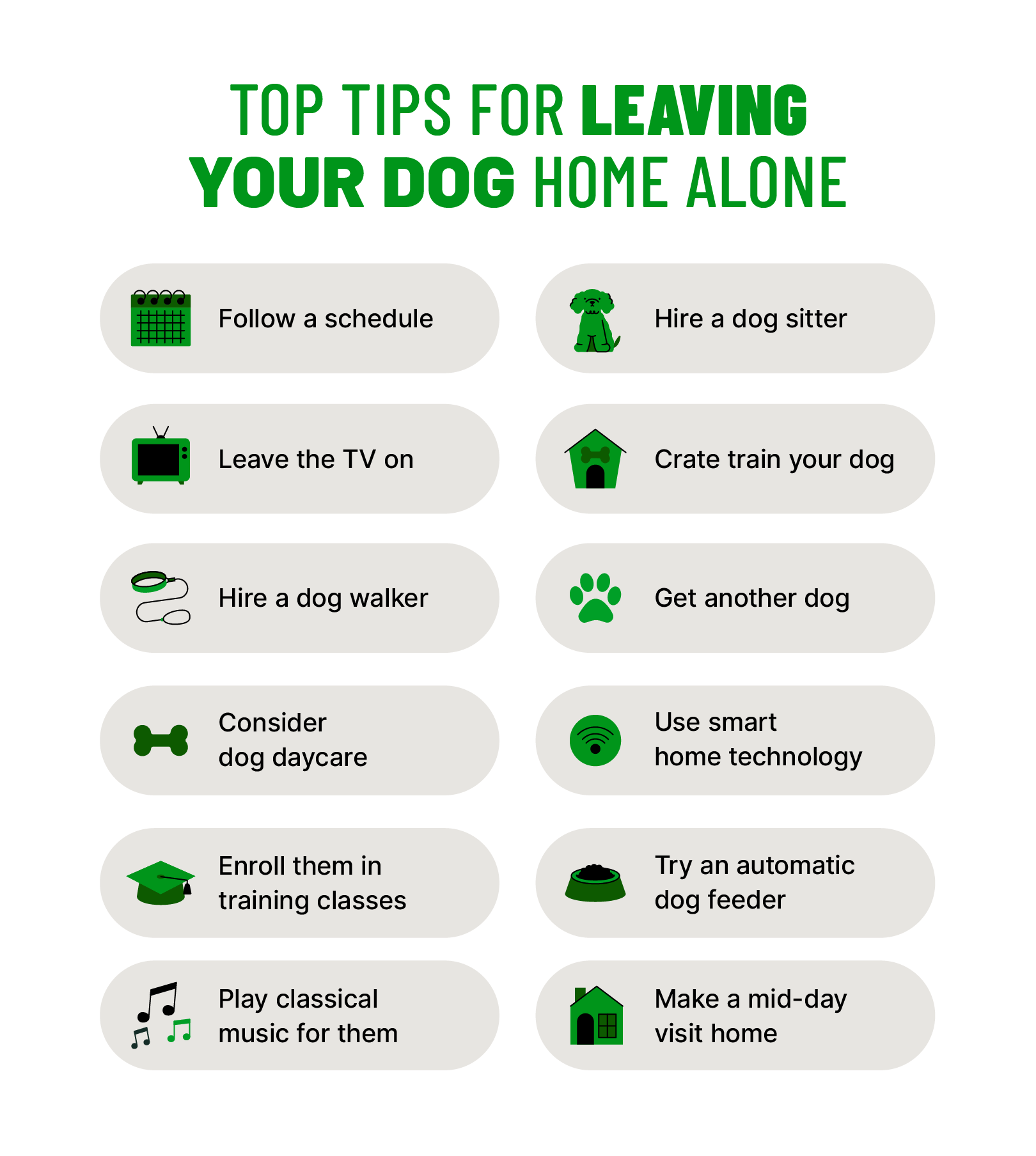
Although leaving furry friends home alone for long periods of time isn’t ideal, it may be necessary depending on your work schedule. Below, we’ve provided tips on how to do so guilt-free with your dog’s best interest in mind.
1. Leave the TV on
Dogs like to watch TV too; leaving the television on while you’re away provides background noise so it’s not eerily quiet. It also prevents your pup from getting startled or anxious from the noises they hear outside. Try putting on a show with other animals like themselves to stimulate your dog’s brain while the house is quiet.
2. Follow a schedule
Dogs like structure and routine, just like us. Creating a predictable schedule that you follow weekly can help your pet feel more secure and less anxious since they know what to expect.
3. Play classical music
Classical music has a reputation for reducing stress levels in dogs, which can come in handy when it comes to our furry friends with separation anxiety. Since dogs hear at a higher frequency than humans, certain genres of music are better than others. Anxious dogs can benefit from reggae and soft rock in addition to classical music.
4. Crate train your dog
Dogs experiencing separation anxiety in the form of crying, barking, and destroying things might benefit from crate training. With the combination of a cozy crate and mat as well as access to food and water, crating alone can reduce the chance of them getting injured or destroying your property. When it comes to leaving a dog in the crate while at work, do not leave them alone for more than a few hours.
For crate training beginners, it’s a good idea to start slow by having your pup in the crate for five to 10 minutes at a time and slowly increasing the amount of time until they’re comfortable. You can also give them a treat for going in the crate when you ask them to! It’s important to note that crate training isn’t the solution for all dogs and depends on your pup.
5. Consider doggy daycare
If your dogs don’t do well at home alone or you work long hours, doggy daycare is an excellent option. Even if it’s just a few times a week, daycare can make a huge difference — your pup can socialize with other dogs, play, and get the exercise they need. Be sure to tell the caretaker how to care for your pet when you drop them off for the first time.
6. Hire a dog walker
Don’t have time to take your dog out for a walk before you head out for the day? Hiring a dog walker can take this off your plate and get your pup the exercise they need. Not only does burning their energy make them less likely to chew on your dining chairs, but it also could help them fall asleep while they’re home alone.
7. Get another dog
What better way to keep your pup company than with one of their own? Getting another dog that gets along with yours and keeps them occupied while you're away can help with your pup's separation anxiety. Senior dogs are better at being home alone, while puppies shouldn’t be left home alone until they’re older, so keep this in mind when getting a new dog.
8. Try an automatic feeder
Some dogs graze while others have designated feeding times. Regardless of your dog’s eating habits, an automatic feeder can take mealtime stress off your mind. If you’re not home during your pup’s lunch, you can schedule meals in advance with wet or dry dog food depending on the feeder.
9. Use a smart home monitoring system
Keep an eye on your pup when you’re away with a smart home system equipped with a camera and sensors. These sensors can protect your pet by detecting smoke and carbon monoxide leaks, water leaks, and even motion to identify intruders. Installing smart home technology can help you identify the warning signs of separation anxiety and comfort your furry friend as soon as you return home.
10. Hire a dog sitter
If you prefer someone you trust to look after your pet while you’re away, consider hiring a dog sitter. This saves you the trouble of having to transport your pet to doggy daycare or leave them home alone. Not only will your pup be occupied with another person, but they’ll receive the exercise and playtime they need to keep them content until your keys rattle the front door.
11. Make a mid-day visit
Pet owners who live close enough to work should consider making a mid-day visit to their puppies. You can use this opportunity to feed them, take them for a walk, or catch them in the act of chewing on your flip-flops — all before you finish your workday.
12. Enroll them in training classes
Sending your pets to puppy school is an excellent way to keep them occupied while you’re away and can help them learn valuable skills like communication and obedience. This is especially good for young puppies who are still growing, learning how to behave, and even potty training.
Take our quiz to help determine whether or not you should leave your dog alone.
How long can you leave your dog alone?
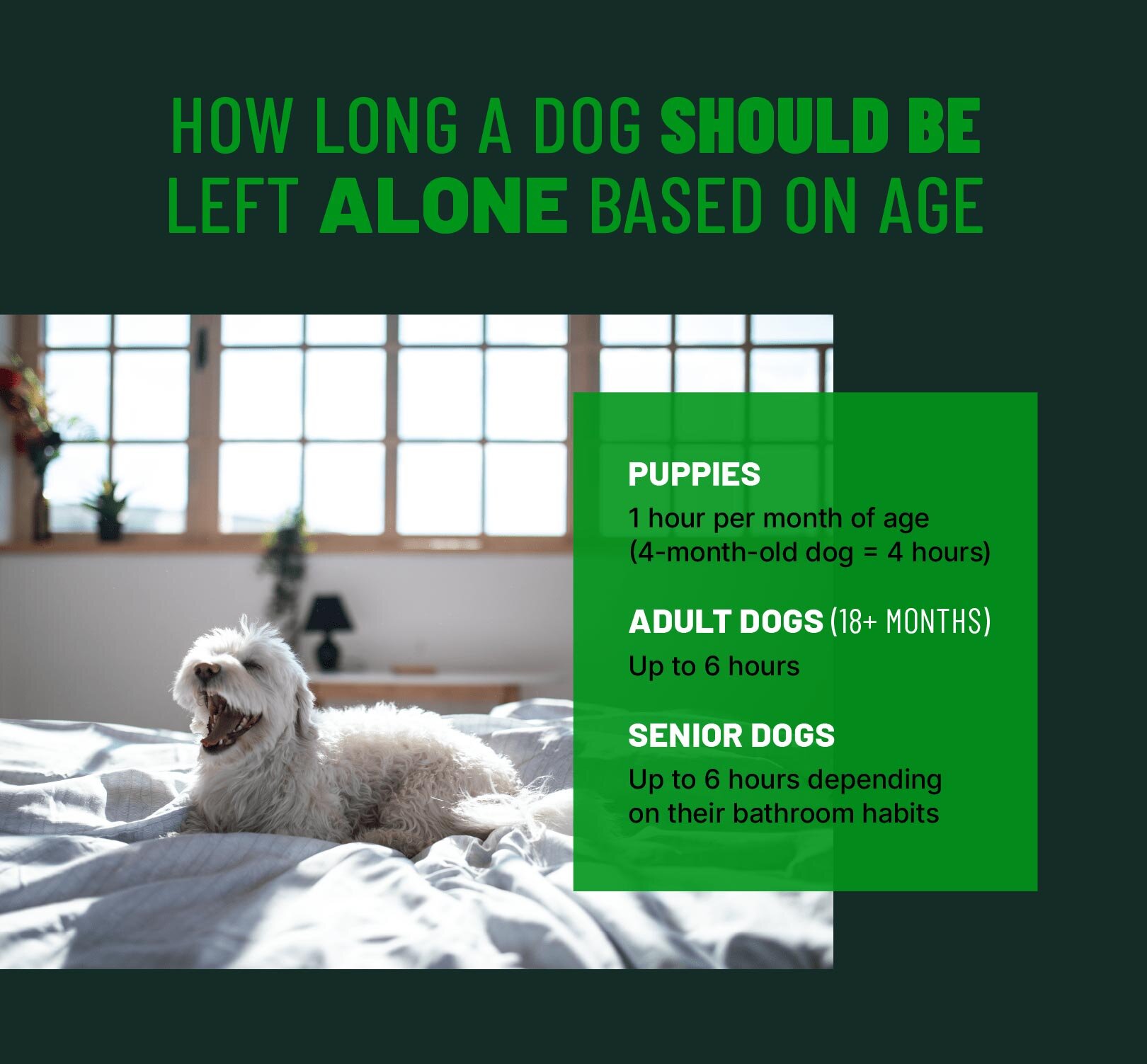
Can you leave your dog alone? Yes, but the amount of time you can depends on the dog. The general rule of thumb is not to leave your dog alone for more than six hours, but it’s even less for puppies or senior dogs.
- Puppies:
- 10-12 weeks: 2 hours
- 3 months: 3 hours
- 4 months: 4 hours
- 5 months: 5 hours
- 6 months: 6 hours
- 7+ months: 6-8 hours maximum
- Adult dogs and senior dogs can be home alone for up to six hours, but senior dogs may need to go to the bathroom more frequently.
Dogs have needs too: They have to eat, go to the bathroom, and spend time with their owner to be happy. Leaving dogs at home for long periods of time can result in loneliness and anxiety.
Signs your dog is having separation anxiety
Just like their humans, dogs can experience separation anxiety when their companions are away. Warning signs that your pup is experiencing separation anxiety include:
- Barking or howling
- Going to the bathroom where they're not supposed to (if they're house trained)
- Destructive behavior (chewing, digging, destroying household objects
- Trying to escape
- Pacing in a fixed pattern repeatedly
If you’ve noticed these warning signs, it's likely your pup is upset while you’re away. Following the tips above can help curb separation anxiety in dogs, but be sure to consult with a veterinarian or dog behavior specialist to uncover the best strategy moving forward.
Protecting your home while you’re away
Dogs can do real damage in the wake of separation anxiety, whether that be chewing on doorways or destroying anything with stuffing. To protect your belongings, homeowners should look for policies that include personal property coverage if their dog has had destructive symptoms of separation anxiety. With the right home insurance, you can be protected no matter what strikes.
